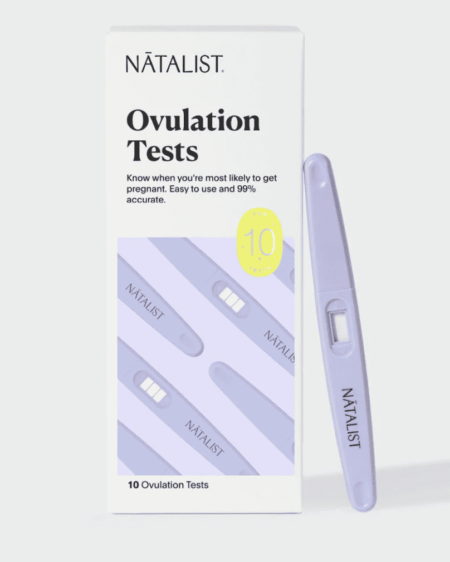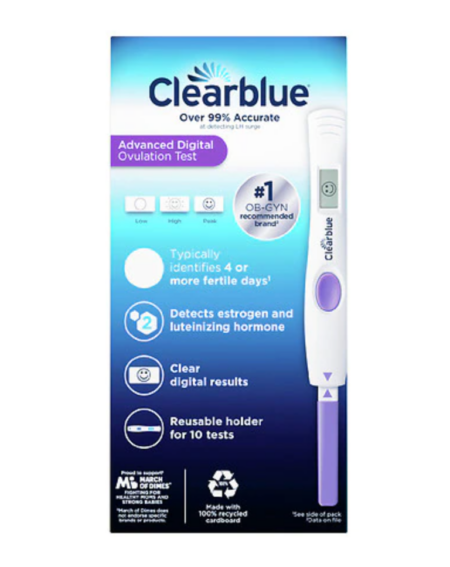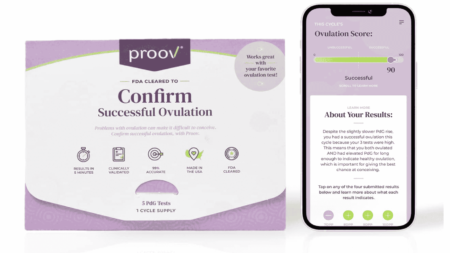Ovulation tests can improve your chances of conceiving, study shows
The tests pinpoint your fertility window better than other fertility awareness methods, but more research is needed.

Dragana Gordic/Shutterstock
We independently select and share the products we love—and may receive a commission if you choose to buy.
Taking a urine test to track ovulation (and then having sexual intercourse when you’re most fertile) may be successful for some couples looking to conceive, according to recent updates on a Cochrane analysis.
The research showed that the chance of pregnancy using timed intercourse after an ovulation test was between 20% to 28% (compared to 18% in couples who had intercourse spontaneously). But lead author Tatjana Gibbons, a student at University of Oxford, said more evidence is needed to know for sure if a correlation exists between using the tests and a higher likelihood of conceiving.
The over-the-counter urine tests predict which days that a woman is most likely to release an egg. These fertility tests detect increases in your urine’s luteinizing hormone (LH) and E3G, which is high around the time you ovulate. Based on that, people know when to have intercourse.
The technology is in a slew of over-the-counter tests. Dr. Gibbons tells Motherly that the study was focused on ovulation predictor tests from Clearblue. Clearblue did not fund the study.
Some urine tests utilize the strips in combination with data via an app, so you can track everything on your smartphone and then know when your best fertility window is. Other period tracking apps simply help you track your menstrual cycle along with other factors and guesstimate when you’re most likely to conceive. There are also wearables (and even an in-ear temperature monitor) that can gauge a variety of physiological parameters to gauge the best times to try to conceive. (Here are our faves.)
Related: Here’s how to talk to your partner about sperm testing, according to a fertility doctor
While the urine tests showed some promise in Gibbons’ research, there wasn’t as much evidence on conception outcomes for other fertility awareness-based contraceptive methods (FABM) methods such as using period tracking apps, calendars, cervical mucus analysis or body temperature devices, Dr. Gibbons noted in a statement.
Dr. Gibbons presented the information at the latest European Society of Human Reproduction and Embryology meeting in early July.
Urine-based ovulation tests: What we know
Previous research has found some benefits of using urine-based ovulation tests compared to other methods. There isn’t much out there in peer-reviewed journals as to the efficacy of other FABM methods, even though we know some markers can indicate ovulation, such as basal body temperature and hormone fluctuations. By testing your urine, ovulation predictor tests offer something a little more concrete.
A 2019 study found that evaluating your level of urine progesterone (pregnanediol-3-glucuronide, PDG), after a surge in LH predicted ovulation perfectly. Urine tests that gauge PDG are already on the market, too.
Behind the results
The Cochrane analysis involved evaluating effectiveness of timed intercourse used in collaboration with ovulation detection methods. Researchers looked at digital apps linked to urine monitors, urine ovulation tests, and other FABM.
Dr. Gibbons’ team reviewed six studies on 2,374 women who were trying to conceive.
The big find: Taking a urine test to detect your best time to ovulate—then having sex during that optimal fertility window—was tied to higher pregnancy rates compared to rates in couples who didn’t plan when they would have intercourse. (Kills the spontaneity factor, we know.)
Related: How to make a baby: The quick & dirty guide to getting pregnant
Here’s where the data gets dicey (or in scientific terms, “inconclusive”): It wasn’t clear if timed intercourse using FABM resulted in a difference in live birth or pregnancy rates, as that data was only available from two studies involving only 160 women. The evidence wasn’t exactly solid.
There was a benefit in couples who were trying to conceive for less than 12 months. But there was “insufficient evidence” that the results could be the same for couples who had been trying for more than 12 months.
Data was also insufficient in terms of finding studies that reported on factors such as how long it took to get pregnant when using the ovulation detection and timed intercourse methods, as well as data on live birth, quality of life and adverse events like stress.
Just this year, a study published about the Clearblue Connected Ovulation Test System correlated test use with live birth rate. (Full disclosure: It was funded by the test manufacturer.)
Predicting fertility
Specifically, Dr. Gibbons said she would like to learn more about any adverse effects of timed intercourse and its effectiveness in different groups, such as people with unexplained infertility. That should be in place before doctors promote the practice. She’d also like to see more research on using fertility awareness-based methods (FABM), she said in a statement.
To sum it up, ovulation predictor tests may be a good way to detect your optimal fertility window. Of course, there are no guarantees that it will lead to conception. Still, for those using the tests hoping to become pregnant, it may offer a glimmer of hope with at least a little data to back it up.
Sources
Bouchard, T., Fehring, R., Schneider, M. Pilot Evaluation of a New Urine Progesterone Test to Confirm Ovulation in Women Using a Fertility Monitor. Frontiers in Public Health. 2019. 7:184. doi:10.3389/fpubh.2019.00184
Johnson, S., Bond, S., Grace, B., et al. Increased Chance of Live Birth Following Use of Connected Ovulation Test System: Outcome Results from a Randomized Controlled Trial. Women’s Health Reports. 2022.60-66. doi:10.1089/whr.2021.0102
Manders M, McLindon L, Schulze B, Beckmann MM, Kremer JA, Farquhar C. Timed intercourse for couples trying to conceive. Cochrane Database Syst Rev. 2015;(3):CD011345. Published 2015 Mar 17. doi:10.1002/14651858.CD011345.pub2
Su HW, Yi YC, Wei TY, Chang TC, Cheng CM, et al. Detection of ovulation, a review of currently available methods. Bioeng Transl Med. 2017 May 16;2(3):238-246. doi: 10.1002/btm2.10058
Yeh PT, Kennedy CE, Van der Poel S, et al. Should home-based ovulation predictor kits be offered as an additional approach for fertility management for women and couples desiring pregnancy? A systematic review and meta-analysis. BMJ Global Health 2019;4:e001403. doi:10.1136/bmjgh-2019-001403






